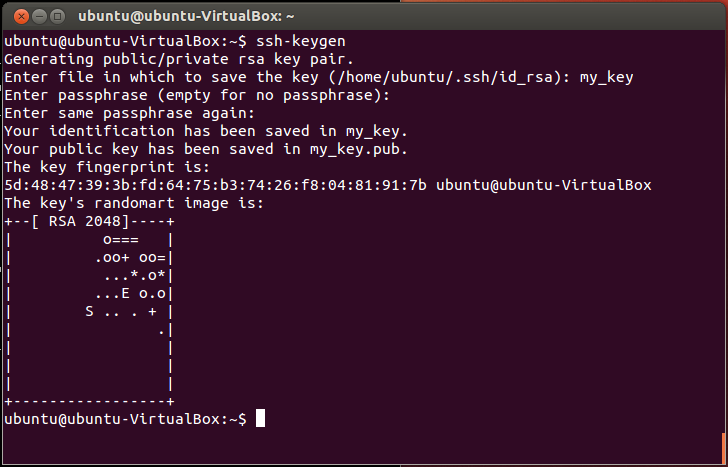SSH stands for Secure Shell and is a cryptographic protocol based on the concept of public-private keys. We are using SSH with Git because it is much easier than typing your username and password.
More Linux resources
- Overview Public key authentication is a way of logging into an SSH/SFTP account using a cryptographic key rather than a password.
- If you use multiple keys, use a bunch of Host entries in /.ssh/config. If it's a one-off connection, use the '-i' option for the ssh command. – cjc Aug 16 '11 at 16:37 @Alex Holst: I have also other keys to install and prefer to differentiate them with easy names. – user60129 Aug 16 '11 at 16:47.
- Most users would simply type ssh-keygen and accept what they're given by default. But what are the best practices for generating ssh keys with ssh-keygen? For example: Use -o for the OpenSSH key format rather than the older PEM format (OpenSSH 6.5 introduced this feature years ago on 2014-01-30).
If you have ever worked as a sysadmin (or you want to in the future), you need a good grasp of SSH. I will not run you through the general concept as it has already been hashed out here at Enable Sysadmin. However, I do want to look at a potentially better way to use it. SSH is the single most used remote access protocol in the world. Therefore, it makes sense that we should try to improve its use as much as possible.

I used SSH to remotely connect to thousands of customer machines during my time as a support engineer, and I am sure that others have had a similar experience. With traditional SSH authentication, you need the username and password for the account you want to log in to every time that you wish to access a system. Doesn't sound that bad, right? But, what happens when you need to jump back and forth between systems regularly? Or what if your responsibilities include remote sessions to the same 100 systems throughout the day for health checks? There is another way to accomplish the log in, and with a little upfront investment, it can be far more efficient overall.
Process hardening
It is objectively true that an encrypted key is a much harder target than a username and password for those with ill intentions. Although it can take a little learning, creating and using SSH key-based authentication is worth the investment for every sysadmin.
Here is how it works. You generate a public key and a matching private key. The private key file acts as a password and should be kept safe. However, the public key is copied to the target systems that you connect to regularly. You place the public key in your account home directory on the target server. When you try to log in, the keys are verified, and access is granted.
Now, there are two ways that you can do this. One is more convenient, and the other is a bit tedious but with added protection to you. The convenient way is not to specify a password along with the private key. The result is that you do not have to enter a password when you use your private key for authentication. This means that if someone gets their hands on your private key, they can use it to authenticate, as well. The other method is to password-protect your private key so that you are prompted for the password when authenticating (think two-factor authentication using both the private key and the password).
ssh-keygen without a password
To generate an SSH key pair, use the following command:
By default, your private and public keys are saved in your ~/.ssh/id_rsa and ~/.ssh/id_rsa.pub files, respectively.
ssh-keygen with a password
Creating a password-protected key looks something like this:
Use the -f option to specify the file where the keys will be saved. In the example above, the private and public keys are stored in the /home/user/.ssh/key-with-pass and /home/user/.ssh/key-with-pass.pub files, respectively.
Warning
During further SSH key pair generation, if you do not specify a unique file name, you are prompted for permission to overwrite the existing id_rsa and id_rsa.pub files. If you overwrite the existing id_rsa and id_rsa.pub files, you must then replace the old public key with the new one on ALL of the SSH servers that have your old public key.
Once you have generated the keys, they are stored in the /user/home/.ssh/ directory with the following permissions:
- Private key - 600
- Public key - 644
Ssh Use Specific Key

You aren't done yet. Let's look at the final step in successful SSH key-based authentication.
Sharing keys
For all of this to work, you need to share your public key with the remote machines you are trying to SSH to. Use the ssh-copy-id command to copy your public key over to the destination system. By default, the file path is /home/user/.ssh/id_rsa.pub. You issue the command, specify the file you are sharing, then the user/host we are sharing it with. It should look like this:

Now that you have shared the public key with the destination host, you can authenticate to the remote server by passing the matching private key. If you specified a file path for your private key, you need to give it here. Otherwise, it defaults to /home/_user_/.ssh/id_rsa.
Seen here:
Advantages and summary
Ssh Which Key To Use On Laptop
The advantages of using SSH key-based authentication are clear. Passwords are stolen every day, mainly due to human error but also due to attacker skill and determination. An encrypted key, and more specifically, a password-protected encrypted key, makes your SSH authentication even more difficult to attack. You still need to strike a balance of availability and security, but that is handled differently in every environment.
[ Free online course: Red Hat Enterprise Linux technical overview. ]
Which Ssh Key Algorithm To Use
Check out these related articles on Enable Sysadmin
